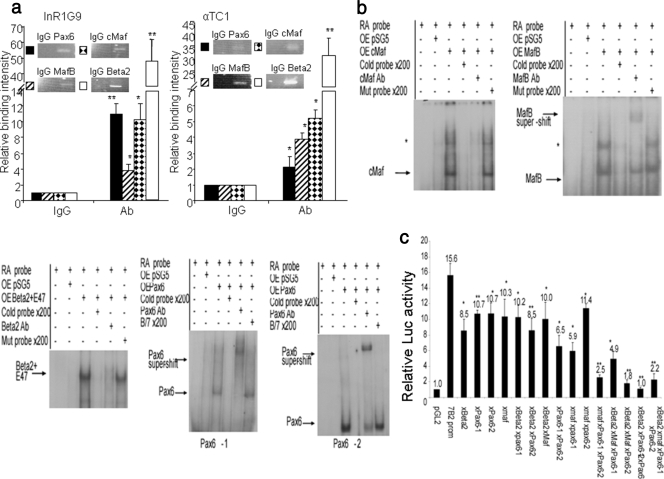FIG. 5.
Direct binding of Pax6, cMaf, MafB, and Beta2/NeuroD1 on the 7B2 promoter. (a) In vivo binding of Pax6, cMaf, MafB, and Beta2/NeuroD1 (Beta2) on the PC2 promoter by ChIP analysis. Histograms represent the relative binding of the Pax6, cMaf, MafB, and Beta2/NeuroD1 proteins on the 7B2 gene promoter in InR1G9 and αTC1 cells. Binding intensity data are expressed relative to IgG immunoprecipitation (nonspecific binding) and are presented as the means ± the standard errors of the means (SEM) for at least three independent experiments. *, P < 0.05. (b) EMSAs were performed with labeled oligonucleotides containing the large-Maf, Beta2/NeuroD1, and Pax6 putative binding sites on the 7B2 gene promoter in the presence of nuclear extracts from HEK cells overexpressing (OE) the empty vector (pSG5), cMaf, MafB, Beta2/NeuroD1/E47, or Pax6. Binding experiments were performed with probes corresponding to the positions of the Beta2/NeuroD1 (−1050 to −1016), Pax6-1 (−539 to −505), pax6-2 (−163 to −129), and large-Maf (−57 to −21) binding sites on the mouse 7B2 promoter. *, Possible heterodimer or homodimer of Maf. (c) Site-directed mutation-containing forms of large-Maf (xMaf), Beta2/NeuroD1 (xBeta2), Pax6 (xPax6-1, and xPax6-2) alone or combined with the mouse 7B2 promoter. InR1G9 cells were transfected with the mutated plasmids of the mouse 7B2 promoter linked to the Luc reporter. Results represent relative Luc and PAP activities over basal activity. Values are the means ± SEM mean from at least three separate experiments, each performed twice. *, P < 0.05; **, P < 0.01 (compared to the WT mouse 7B2 promoter).

